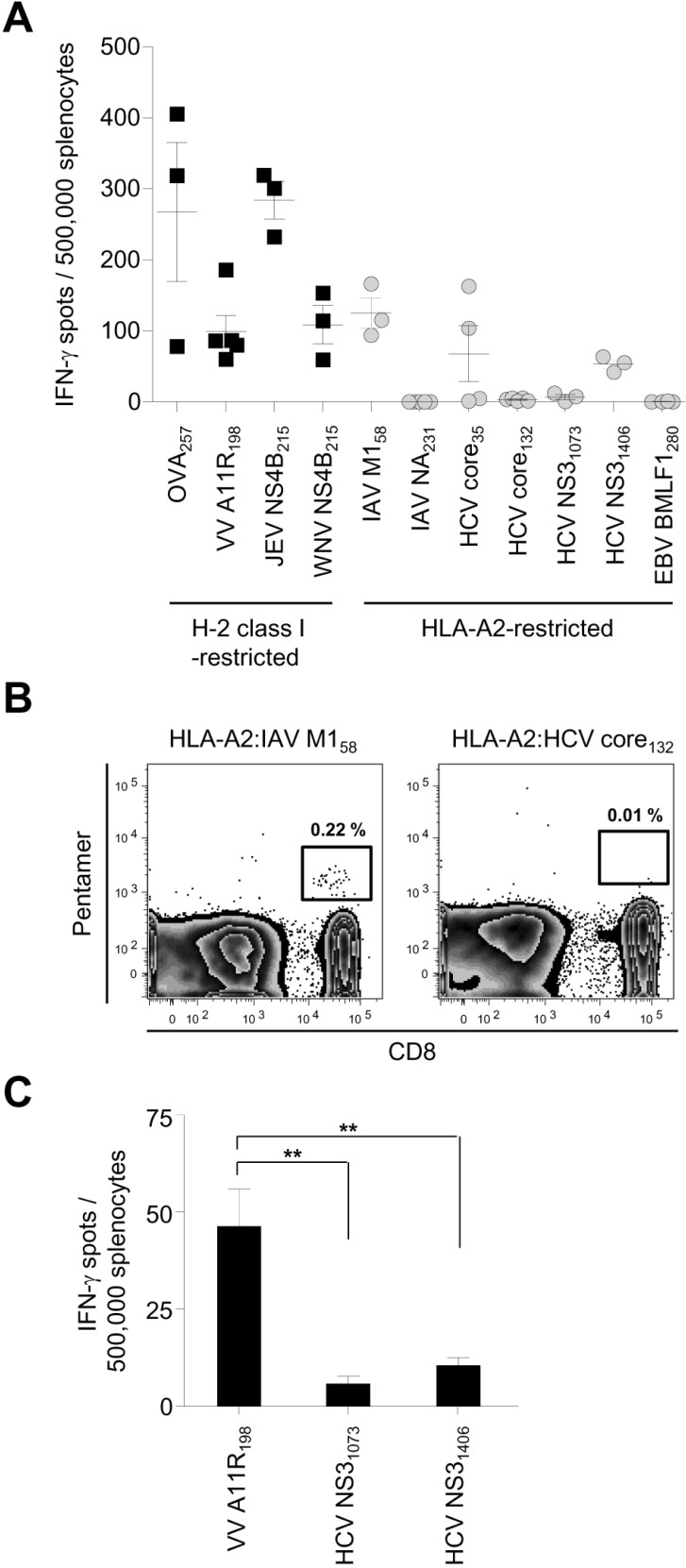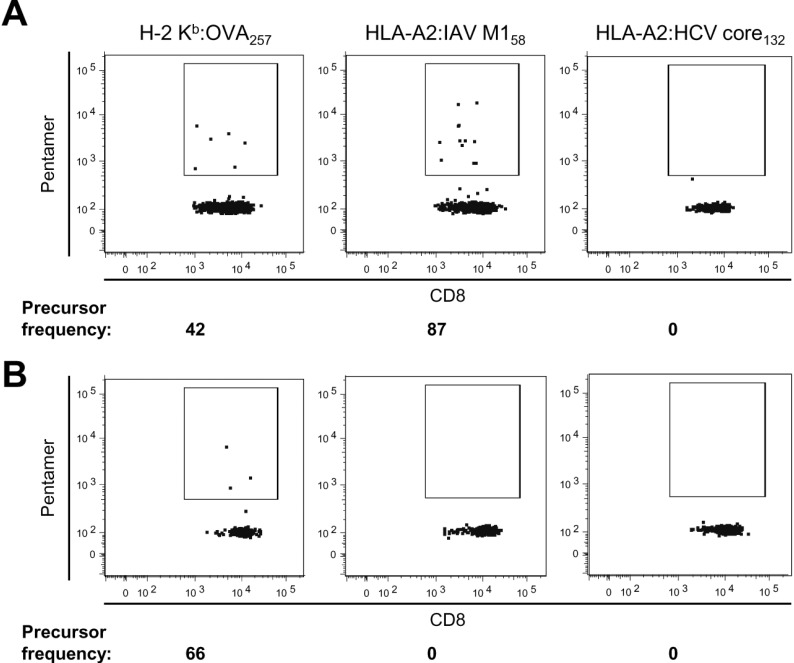Immune Netw.
2014 Aug;14(4):219-225. 10.4110/in.2014.14.4.219.
Relationship between Poor Immunogenicity of HLA-A2-Restricted Peptide Epitopes and Paucity of Naive CD8+ T-Cell Precursors in HLA-A2-Transgenic Mice
- Affiliations
-
- 1Laboratory of Immunology and Infectious Diseases, Graduate School of Medical Science and Engineering, KAIST, Daejeon 305-701, Korea. ecshin@kaist.ac.kr
- 2Department of Internal Medicine, Chungnam National University College of Medicine, Daejeon 301-721, Korea.
- KMID: 2150810
- DOI: http://doi.org/10.4110/in.2014.14.4.219
Abstract
- We examined the immunogenicity of H-2 class I-restricted and HLA-A2-restricted epitopes through peptide immunization of HLA-A2-transgenic mice that also express mouse H-2 class I molecules. All four of the tested epitopes restricted by H-2 class I robustly elicited T-cell responses, but four of seven epitopes restricted by HLA-A2 did not induce T-cell responses, showing that HLA-A2-restricted peptide epitopes tend to be poorly immunogenic in HLA-A2-transgenic mice. This finding was confirmed in HLA-A2-transgenic mice infected with a recombinant vaccinia virus expressing hepatitis C virus proteins. We examined the precursor frequency of epitope-specific naive CD8+ T cells in HLA-A2-transgenic and conventional C57BL/6 mice and found that the poor immunogenicity of HLA-A2-restricted peptide epitopes is related to the paucity of naive CD8+ T-cell precursors in HLA-A2-transgenic mice. These results provide direction for the improvement of mouse models to study epitope repertoires and the immunodominance of human T-cell responses.
Keyword
MeSH Terms
Figure
Cited by 1 articles
-
Herpes Zoster DNA Vaccines with IL-7 and IL-33 Molecular Adjuvants Elicit Protective T Cell Immunity
A Reum Kim, Junsik Park, Jong Hoon Kim, Jeong-Eun Kwak, Youngran Cho, Hyojin Lee, Moonsup Jeong, Su-Hyung Park, Eui-Cheol Shin
Immune Netw. 2018;18(5):. doi: 10.4110/in.2018.18.e38.
Reference
-
1. Spits H. Development of alphabeta T cells in the human thymus. Nat Rev Immunol. 2002; 2:760–772. PMID: 12360214.2. Barry M, Bleackley RC. Cytotoxic T lymphocytes: all roads lead to death. Nat Rev Immunol. 2002; 2:401–409. PMID: 12093006.
Article3. Yewdell JW, Bennink JR. Immunodominance in major histocompatibility complex class I-restricted T lymphocyte responses. Annu Rev Immunol. 1999; 17:51–88. PMID: 10358753.
Article4. Jenkins MK, Moon JJ. The role of naive T cell precursor frequency and recruitment in dictating immune response magnitude. J Immunol. 2012; 188:4135–4140. PMID: 22517866.
Article5. Kotturi MF, Scott I, Wolfe T, Peters B, Sidney J, Cheroutre H, von Herrath MG, Buchmeier MJ, Grey H, Sette A. Naive precursor frequencies and MHC binding rather than the degree of epitope diversity shape CD8+ T cell immunodominance. J Immunol. 2008; 181:2124–2133. PMID: 18641351.6. Obar JJ, Khanna KM, Lefrançois L. Endogenous naive CD8+ T cell precursor frequency regulates primary and memory responses to infection. Immunity. 2008; 28:859–869. PMID: 18499487.7. Epstein H, Hardy R, May JS, Johnson MH, Holmes N. Expression and function of HLA-A2.1 in transgenic mice. Eur J Immunol. 1989; 19:1575–1583. PMID: 2676561.
Article8. Le AX, Bernhard EJ, Holterman MJ, Strub S, Parham P, Lacy E, Engelhard VH. Cytotoxic T cell responses in HLA-A2.1 transgenic mice. Recognition of HLA alloantigens and utilization of HLA-A2.1 as a restriction element. J Immunol. 1989; 142:1366–1371. PMID: 2464645.9. Vitiello A, Marchesini D, Furze J, Sherman LA, Chesnut RW. Analysis of the HLA-restricted influenza-specific cytotoxic T lymphocyte response in transgenic mice carrying a chimeric human-mouse class I major histocompatibility complex. J Exp Med. 1991; 173:1007–1015. PMID: 1706750.
Article10. Nickerson CL, Hanson J, David CS. Expression of HLA-B27 in transgenic mice is dependent on the mouse H-2D genes. J Exp Med. 1990; 172:1255–1261. PMID: 2212952.
Article11. Alexander J, Oseroff C, Sidney J, Wentworth P, Keogh E, Hermanson G, Chisari FV, Kubo RT, Grey HM, Sette A. Derivation of HLA-A11/Kb transgenic mice: functional CTL repertoire and recognition of human A11-restricted CTL epitopes. J Immunol. 1997; 159:4753–4761. PMID: 9366399.12. Alexander J, Oseroff C, Sidney J, Sette A. Derivation of HLA-B*0702 transgenic mice: functional CTL repertoire and recognition of human B*0702-restricted CTL epitopes. Hum Immunol. 2003; 64:211–223. PMID: 12559623.
Article13. Pascolo S, Bervas N, Ure JM, Smith AG, Lemonnier FA, Pérarnau B. HLA-A2.1-restricted education and cytolytic activity of CD8(+) T lymphocytes from beta2 microglobulin (beta2m) HLA-A2.1 monochain transgenic H-2Db beta2m double knockout mice. J Exp Med. 1997; 185:2043–2051. PMID: 9182675.14. Firat H, Garcia-Pons F, Tourdot S, Pascolo S, Scardino A, Garcia Z, Michel ML, Jack RW, Jung G, Kosmatopoulos K, Mateo L, Suhrbier A, Lemonnier FA, Langlade-Demoyen P. H-2 class I knockout, HLA-A2.1-transgenic mice: a versatile animal model for preclinical evaluation of antitumor immunotherapeutic strategies. Eur J Immunol. 1999; 29:3112–3121. PMID: 10540322.
Article15. Firat H, Cochet M, Rohrlich PS, Garcia-Pons F, Darche S, Danos O, Lemonnier FA, Langlade-Demoyen P. Comparative analysis of the CD8(+) T cell repertoires of H-2 class I wild-type/HLA-A2.1 and H-2 class I knockout/HLA-A2.1 transgenic mice. Int Immunol. 2002; 14:925–934. PMID: 12147629.
Article16. Newberg MH, Smith DH, Haertel SB, Vining DR, Lacy E, Engelhard VH. Importance of MHC class 1 alpha2 and alpha3 domains in the recognition of self and non-self MHC molecules. J Immunol. 1996; 156:2473–2480. PMID: 8786307.17. Martin S, Ortmann B, Pflugfelder U, Birsner U, Weltzien HU. Role of hapten-anchoring peptides in defining hapten-epitopes for MHC-restricted cytotoxic T cells. Cross-reactive TNP-determinants on different peptides. J Immunol. 1992; 149:2569–2575. PMID: 1383319.18. Kim SK, Cornberg M, Wang XZ, Chen HD, Selin LK, Welsh RM. Private specificities of CD8 T cell responses control patterns of heterologous immunity. J Exp Med. 2005; 201:523–533. PMID: 15710651.
Article19. Trobaugh DW, Yang L, Ennis FA, Green S. Altered effector functions of virus-specific and virus cross-reactive CD8+ T cells in mice immunized with related flaviviruses. Eur J Immunol. 2010; 40:1315–1327. PMID: 20213733.20. Clute SC, Watkin LB, Cornberg M, Naumov YN, Sullivan JL, Luzuriaga K, Welsh RM, Selin LK. Cross-reactive influenza virus-specific CD8+ T cells contribute to lymphoproliferation in Epstein-Barr virus-associated infectious mononucleosis. J Clin Invest. 2005; 115:3602–3612. PMID: 16308574.21. Wedemeyer H, Mizukoshi E, Davis AR, Bennink JR, Rehermann B. Cross-reactivity between hepatitis C virus and Influenza A virus determinant-specific cytotoxic T cells. J Virol. 2001; 75:11392–11400. PMID: 11689620.
Article22. Wedemeyer H, He XS, Nascimbeni M, Davis AR, Greenberg HB, Hoofnagle JH, Liang TJ, Alter H, Rehermann B. Impaired effector function of hepatitis C virus-specific CD8+ T cells in chronic hepatitis C virus infection. J Immunol. 2002; 169:3447–3458. PMID: 12218168.23. Thimme R, Oldach D, Chang KM, Steiger C, Ray SC, Chisari FV. Determinants of viral clearance and persistence during acute hepatitis C virus infection. J Exp Med. 2001; 194:1395–1406. PMID: 11714747.
Article24. Wentworth PA, Vitiello A, Sidney J, Keogh E, Chesnut RW, Grey H, Sette A. Differences and similarities in the A2.1-restricted cytotoxic T cell repertoire in humans and human leukocyte antigen-transgenic mice. Eur J Immunol. 1996; 26:97–101. PMID: 8566090.
Article25. Wedemeyer H, Gagneten S, Davis A, Bartenschlager R, Feinstone S, Rehermann B. Oral immunization with HCV-NS3-transformed Salmonella: induction of HCV-specific CTL in a transgenic mouse model. Gastroenterology. 2001; 121:1158–1166. PMID: 11677208.
Article26. Lee DH, Kim SH, Kang W, Choi YS, Lee SH, Lee SR, You S, Lee HK, Chang KT, Shin EC. Adjuvant effect of bacterial outer membrane vesicles with penta-acylated lipopolysaccharide on antigen-specific T cell priming. Vaccine. 2011; 29:8293–8301. PMID: 21893142.
Article27. Moon JJ, Chu HH, Pepper M, McSorley SJ, Jameson SC, Kedl RM, Jenkins MK. Naive CD4(+) T cell frequency varies for different epitopes and predicts repertoire diversity and response magnitude. Immunity. 2007; 27:203–213. PMID: 17707129.
Article28. Altmann DM, Douek DC, Frater AJ, Hetherington CM, Inoko H, Elliott JI. The T cell response of HLA-DR transgenic mice to human myelin basic protein and other antigens in the presence and absence of human CD4. J Exp Med. 1995; 181:867–875. PMID: 7532684.
Article29. Nabozny GH, Baisch JM, Cheng S, Cosgrove D, Griffiths MM, Luthra HS, David CS. HLA-DQ8 transgenic mice are highly susceptible to collagen-induced arthritis: a novel model for human polyarthritis. J Exp Med. 1996; 183:27–37. PMID: 8551230.
Article30. Rosloniec EF, Brand DD, Myers LK, Esaki Y, Whittington KB, Zaller DM, Woods A, Stuart JM, Kang AH. Induction of autoimmune arthritis in HLA-DR4 (DRB1*0401) transgenic mice by immunization with human and bovine type II collagen. J Immunol. 1998; 160:2573–2578. PMID: 9510154.
- Full Text Links
- Actions
-
Cited
- CITED
-
- Close
- Share
- Similar articles
-
- The Study of MHC class I Restricted CD8+ T Cell Mediated Immune Responses against Mycobacterium tuberculosis Infection: Evidence of M. tuberculosis Specific CD8+ T Cells in TB Patients and PPD+ Healthy Individuals
- Detection of HLA-A2 subtypes by one-dimensional isoelectric focusing patterns in Korean
- Reconstitution of class I MHC molecules expressed in E. coli and complexed with single antigenic peptides
- The Distribution of HLA - A * 02 Subtypes in Koreans
- Positive Selection of Transgenic CD4 T Cells in the Restricted Peptide Environment



